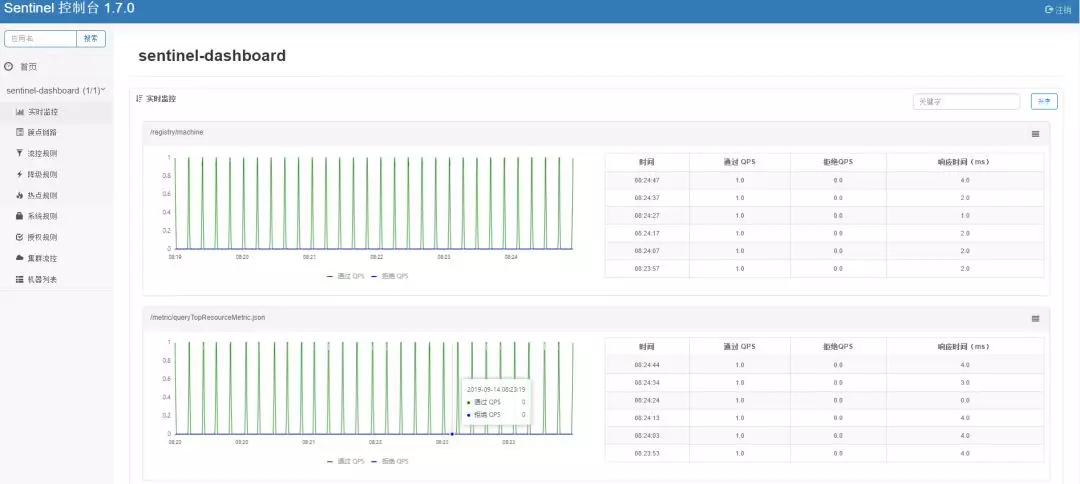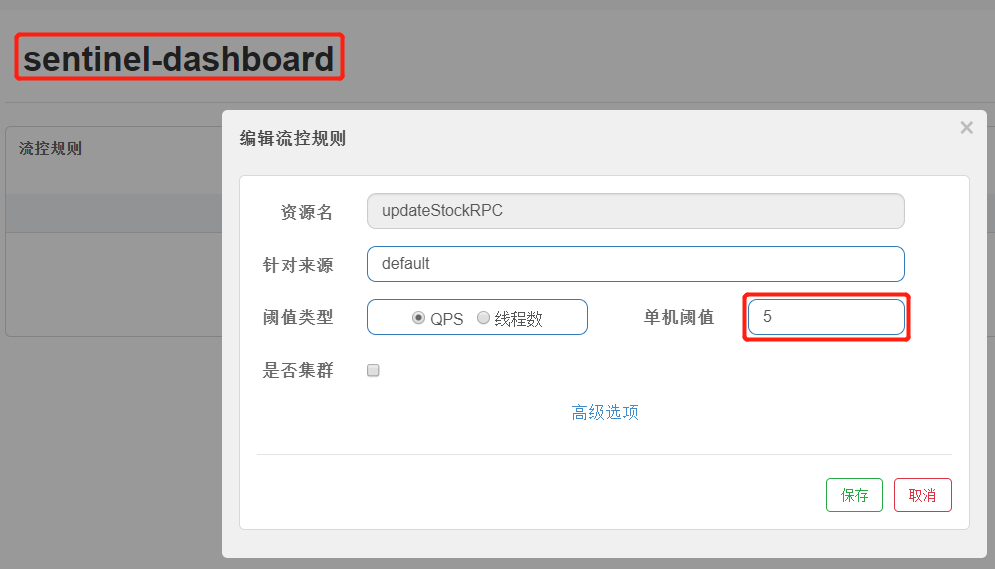Dubbo学习系列之十一(Dashboard+Nacos规则推送)
中国武术,门派林立,都是号称多少代的XXX传人,结果在面对现代武术时,经常被KO秒杀,为啥,光靠宣传和口号撑门面,终究是靠不住,必须得有真货 ,得经得住考验,所以不能只说Sentinel有多好,也得给出些证据,那么,前文实践了规则生成和使用,再来看看SentinelDashboard,体验下是否真如宣传的那么强大,并配合Nacos做规则统一配置和推送,下面我们就来操作一把,内容较多,分两部分。
作者原创文章,谢绝一切转载!
本文只发表在"公众号"和"博客园",其他均属复制粘贴!如果觉得排版不清晰,请查看公众号文章。
工具: Idea201902/JDK11/ZK3.5.5/Gradle5.4.1/RabbitMQ3.7.13/Mysql8.0.11/Lombok0.26/Erlang21.2/postman7.5.0/Redis3.2/RocketMQ4.5.2/Sentinel1.6.3/SpringBoot2.1.6/Nacos1.1.3
难度: 新手--战士--老兵--大师
目标:
-
使用SentinelDashboard实现规则配置
-
使用Nacos实现规则统一管理、持久化和推送
步骤:
整体框架依旧,多模块微服务架构商城系统后台,一个共享模块,多个功能模块,暂时无前台。
Part One:
用SentinelDashboard实现规则配置
1.先看下SentinelDashboard界面:

左侧为接入的应用和机器,并将各类规则独立管理,工作区之一就是各类监控数据,实现了规则管理的可视化操作和系统监控台。
2.引入sentinel-dubbo-adapter这个依赖,可以将Dubbo 的服务接口和方法(包括调用端和服务端)自动设置成为 Sentinel 中的资源,
compile group: 'com.alibaba.csp', name: 'sentinel-dubbo-adapter', version: '1.6.3'
3.进入SentinelDashboard的jar包目录,使用命令运行:
java -Dserver.port=8718 -Dcsp.sentinel.dashboard.server=localhost:8718 -Dproject.name=sentinel-dashboard -Dcsp.sentinel.api.port=8719 -jar sentinel-dashboard.jar
-
Dserver.port=8718 控制台端口,sentinel控制台是一个spring boot程序。
-
Dcsp.sentinel.dashboard.server=localhost:8718 控制台的地址,指定控制台后客户端会自动向该地址发送心跳包。
-
Dproject.name=sentinel-dashboard 指定Sentinel控制台程序的名称
-
Dcsp.sentinel.api.port=8719 (默认8719) 客户端提供给Dashboard访问或者查看Sentinel的运行访问的参数
另外:csp.sentinel.dashboard.server这个配置是用在客户端,这里Sentinel控制台也使用是用于自己监控自己程序的api,否则无法显示控制台的api情况,当然这个也可以根据情况不显示。
启动成功,注意下图中的log地址,所有规则执行过程都有日志记录:

4.启动项目,ZK-->Redis-->RabbitMQ-->RocketMQ-->Nacos-->business-->stock-->logistic-->finance,RabbitMQ我安装为window服务,设置为自动启动,当然,其他如Redis也可以照做,只要你硬件够硬。
5.URL访问:http://localhost:8718,可以看到business模块中有dubbo的@Service注解服务都自动识别为resource,这样代码中就可以直接使用了,印证前面的第2点,

同时,前文通过代码设置的流控规则也可见于此:
this.initFlowQpsRule("saveOrder");

优先级问题:
-
如果我这里将saveOrder阀值设置为0,结果会怎样?测试-->保存订单成功,说明
代码内规则优先级高于外部配置。 -
如果有多个对同一resource的相同类型的规则,经验证,结论为
按最严格规则执行,下图中情形将按照阀值为0执行热点规则:

6.再对saveOrder修改为一个“热点规则”,即可实时注入到应用内存中,规则立即生效,运行postman测试,就会显示拒绝结果!
另外:当应用关闭,那么这些规则将全部清除,因心跳检测会失败,没有应用可以使用这些规则,也说明规则并未持久化。
Part Two:
使用Nacos实现规则统一管理、持久化和推送
1.背景知识:sentinel规则缓存在应用机器内存中,前篇通过API硬编码规则的方式一般仅用于测试和演示,生产上一般通过动态规则源的方式来管理规则,数据源扩展常见的实现方式有:
拉模式:客户端主动向某个规则管理中心定期轮询拉取规则,这个规则中心可以是 RDBMS、文件,甚至是 VCS 等。简单,缺点是无法及时获取变更;

推模式:规则中心统一推送,客户端通过注册监听器的方式时刻监听变化,比如使用 Nacos、Zookeeper 等配置中心。有更好的实时性和一致性保证。

流程为:配置中心控制台/Sentinel 控制台 → 配置中心 → Sentinel 数据源 → Sentinel
Sentinel 目前支持以下数据源扩展:
Pull-based: 文件、Consul (since 1.7.0)
Push-based: ZooKeeper, Redis, Nacos, Apollo
2.这里实现基于Nacos的push模式的动态流控规则,以改造stock模块为例,添加依赖:
testCompile group: 'com.alibaba.csp', name: 'sentinel-datasource-nacos', version: '1.6.3'
//
compile group: 'com.alibaba.nacos', name: 'nacos-api', version: '1.1.3'
3.因为SentinelDashboard原始版本没有同步Nacos的逻辑,故需要修改源码做适配,下载源码项目(V1.7.0)后,pom文件中,注释掉scope行,使datasource-nacos生效:
<!-- for Nacos rule publisher sample -->
<dependency>
<groupId>com.alibaba.csp</groupId>
<artifactId>sentinel-datasource-nacos</artifactId>
<!--此行注释掉<scope>test</scope>-->
</dependency>
4.将\Sentinel\sentinel-dashboard\src\test\java\com\alibaba\csp\sentinel\dashboard\rule\nacos这个nacos目录复制到\Sentinel\sentinel-dashboard\src\main\java\com\alibaba\csp\sentinel\dashboard\rule下,形成如下结构:

5.看下这几个类: com.alibaba.csp.sentinel.dashboard.rule.nacos.NacosConfigUtil 工具类,实际就是定义了一些常量,略,
public final class NacosConfigUtil { public static final String GROUP_ID = "SENTINEL_GROUP"; public static final String FLOW_DATA_ID_POSTFIX = "-flow-rules"; public static final String PARAM_FLOW_DATA_ID_POSTFIX = "-param-rules"; public static final String CLUSTER_MAP_DATA_ID_POSTFIX = "-cluster-map"; /** * cc for `cluster-client` */ public static final String CLIENT_CONFIG_DATA_ID_POSTFIX = "-cc-config"; /** * cs for `cluster-server` */ public static final String SERVER_TRANSPORT_CONFIG_DATA_ID_POSTFIX = "-cs-transport-config"; public static final String SERVER_FLOW_CONFIG_DATA_ID_POSTFIX = "-cs-flow-config"; public static final String SERVER_NAMESPACE_SET_DATA_ID_POSTFIX = "-cs-namespace-set"; private NacosConfigUtil() {} }
com.alibaba.csp.sentinel.dashboard.rule.nacos.NacosConfig 配置类,注入String和List<FlowRuleEntity>互相转换的转换器,这里使用了JDK8语法,返回函数:
@Configuration public class NacosConfig { @Bean public Converter<List<FlowRuleEntity>, String> flowRuleEntityEncoder() { return JSON::toJSONString; } @Bean public Converter<String, List<FlowRuleEntity>> flowRuleEntityDecoder() { return s -> JSON.parseArray(s, FlowRuleEntity.class); } @Bean public ConfigService nacosConfigService() throws Exception { return ConfigFactory.createConfigService("localhost"); } }
com.alibaba.csp.sentinel.dashboard.rule.nacos.FlowRuleNacosProvider 即从Nacos获得应用的流控规则:
@Component("flowRuleNacosProvider")
public class FlowRuleNacosProvider implements DynamicRuleProvider<List<FlowRuleEntity>> {
@Autowired
private ConfigService configService;
@Autowired
private Converter<String, List<FlowRuleEntity>> converter;
@Override
public List<FlowRuleEntity> getRules(String appName) throws Exception {
String rules = configService.getConfig(appName + NacosConfigUtil.FLOW_DATA_ID_POSTFIX,
NacosConfigUtil.GROUP_ID, 3000);
if (StringUtil.isEmpty(rules)) {
return new ArrayList<>();
}
return converter.convert(rules);
}
}
根据应用名,将规则发布到远程配置中心:
@Component("flowRuleNacosPublisher")
public class FlowRuleNacosPublisher implements DynamicRulePublisher<List<FlowRuleEntity>> {
@Autowired
private ConfigService configService;
@Autowired
private Converter<List<FlowRuleEntity>, String> converter;
@Override
public void publish(String app, List<FlowRuleEntity> rules) throws Exception {
AssertUtil.notEmpty(app, "app name cannot be empty");
if (rules == null) {
return;
}
configService.publishConfig(app + NacosConfigUtil.FLOW_DATA_ID_POSTFIX,
NacosConfigUtil.GROUP_ID, converter.convert(rules));
}
}
6.修改com.alibaba.csp.sentinel.dashboard.controller.v2.FlowControllerV2,原文:
@Autowired @Qualifier("flowRuleDefaultProvider") private DynamicRuleProvider<List<FlowRuleEntity>> ruleProvider; @Autowired @Qualifier("flowRuleDefaultPublisher") private DynamicRulePublisher<List<FlowRuleEntity>> rulePublisher;
修改要注入的Bean,使用前面复制来的Provider和Publisher,修改为:
@Autowired @Qualifier("flowRuleNacosProvider") private DynamicRuleProvider<List<FlowRuleEntity>> ruleProvider; @Autowired @Qualifier("flowRuleNacosPublisher") private DynamicRulePublisher<List<FlowRuleEntity>> rulePublisher;
7.修改文件: Sentinel\sentinel-dashboard\src\main\webapp\resources\app\scripts\directives\sidebar\sidebar.html 将
<!--<li ui-sref-active="active">-->
<!--<a ui-sref="dashboard.flow({app: entry.app})">-->
<!--<i class="glyphicon glyphicon-filter"></i> 流控规则同步</a>-->
<!--</li>-->
修改为如下,开启SentinelDashboard左侧的菜单:
<li ui-sref-active="active" ng-if="entry.appType==0"> <a ui-sref="dashboard.flow({app: entry.app})"> <i class="glyphicon glyphicon-filter"></i> 流控规则同步</a> </li>
8.重新打包,运行sentinel-dashboard.jar(见第3点),重新生成的jar运行效果:

9.测试:
测试1:在SentinelDashboard【流控规则同步】中新建流控规则,规则会存储到Nacos;
测试2:直接在Nacos上修改流控规则,然后刷新SentinelDashboard,显示也会被修改;
测试3:重启Sentinel控制台,并重启微服务;刷新控制台,可以发现规则依然存在。
SentinelDashboard中建立一个流控规则:

对应Nacos中的生成的内容:

至此,完成了流控规则的持久化!其他规则持久化类似,略。
10.最后是微服务中同步Nacos,需使用sentinel-datasource-nacos依赖,然后创建 NacosDataSource 并将其注册至对应的 RuleManager 上即可: 改造下logistic模块,先写一个工具类:com.biao.mall.logistic.util.SentinelRuleUtil 注意这里的变量值是从bootstrap.yml加载的,为啥?因为从application.yml中将无法取值。
public class SentinelRuleUtil { // nacos server ip private static final String remoteAddress = "${spring.cloud.sentinel.datasource.flow.nacos.server-addr}"; // nacos group private static final String groupId = "${spring.cloud.sentinel.datasource.flow.nacos.groupId}"; // nacos dataId private static final String dataId = "${spring.cloud.sentinel.datasource.flow.nacos.dataId}"; // if change to true, should be config NACOS_NAMESPACE_ID private static boolean isDemoNamespace = false; // fill your namespace id,if you want to use namespace. // for example: 0f5c7314-4983-4022-ad5a-347de1d1057d,you can get it on nacos's console private static final String NACOS_NAMESPACE_ID = "0f5c7314-4983-4022"; public static void loadFlowRules(){ // public NacosDataSource(final String serverAddr, final String groupId, final String dataId, // Converter<String, T> parser) ReadableDataSource<String, List<FlowRule>> flowDataSource = new NacosDataSource<>(remoteAddress,groupId,dataId, source -> JSON.parseObject(source, new TypeReference<List<FlowRule>>(){ })); FlowRuleManager.register2Property(flowDataSource.getProperty()); } private static void loadMyNamespaceRules() { Properties properties = new Properties(); properties.put("serverAddr",remoteAddress); properties.put("namespace",NACOS_NAMESPACE_ID); //NacosDataSource(final Properties properties, final String groupId, final String dataId, // Converter<String, T> parser) ReadableDataSource<String, List<FlowRule>> flowRuleDataSource = new NacosDataSource<>(properties,groupId,dataId, source -> JSON.parseObject(source, new TypeReference<List<FlowRule>>() { })); FlowRuleManager.register2Property(flowRuleDataSource.getProperty()); }
11.再修改下com.biao.mall.logistic.controller.DubboDeliveryController 使用注解定义一个资源,然后使用上面的Util加载从Nacos获取规则,
@SentinelResource(value = "saveOneDelivery") @PostMapping("/delivery/one") public ResEntity<String> saveOneDelivery(@RequestBody String jsonString) throws BlockException { // Method method = this.getClazz().getMethod("saveOneDelivery"); // String resourceName = "saveOneDelivery"; // try(Entry entry = SphU.entry(resourceName)){ JSONObject jsonObject = (JSONObject) JSON.parse(jsonString); String orderId = jsonObject.getString("orderId"); //保存待发一个物流单 deliveryService.saveLogisticSheet(orderId); //响应封装 ResEntity<String> resEntity = new ResEntity<>(); resEntity.setCode(ResConstant.SUCCESS_CODE); resEntity.setMsg(ResConstant.SUCCESS_STRING); resEntity.setData("delivery received."); return resEntity; }
12.在com.biao.mall.logistic.controller.DubboDeliveryController中使用静态块动态加载规则。
@RestController public class DubboDeliveryController { static { //从Nacos动态加载规则,static标签,可以让规则只加载一次 SentinelRuleUtil.loadFlowRules(); } ... }
13.测试: 先在SentinelDashboard中建一个流控规则,然后可以看到自动同步到Nacos中,访问logistic模块,SentinelDashboard中就可以看到监控数据,贴图,略。
14.代码地址:其中的day 14
https://github.com/xiexiaobiao/dubbo-project.git
后记:
1.目前SentinelDashboard可下载官方版本为1.6.3,下载地址:https://github.com/alibaba/Sentinel/releases,1.7.0需要自行编译打包生成,生成jar包可能遇到的问题,我已在前文(Dubbo学习系列之十(Sentinel之限流与降级))中的后记部分做了些说明。
2.若RocketMQ安装在Linux虚拟机上,推荐在正常运行时,保存个Snapshot,每次使用,直接恢复到快照,快捷迅速,
3.必须注意:QPS统计的是通过REST调用的请求数量;
4.SentinelDashboard运行后,需要应用先运行产生实际流量,才会开始统计规则监控数据。
![]()
推荐阅读:






【推荐】编程新体验,更懂你的AI,立即体验豆包MarsCode编程助手
【推荐】凌霞软件回馈社区,博客园 & 1Panel & Halo 联合会员上线
【推荐】抖音旗下AI助手豆包,你的智能百科全书,全免费不限次数
【推荐】博客园社区专享云产品让利特惠,阿里云新客6.5折上折
【推荐】轻量又高性能的 SSH 工具 IShell:AI 加持,快人一步